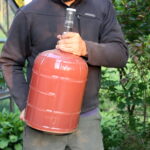Plum Wine
Plum wine is a classic country wine that's sure to please! This recipe is sized for a 1 gallon batch, but it can be increased.
Servings: 20 servings, Mglasses, makes 1 gallon (about 4 bottles)
Ingredients
- 6 lbs Plums
- 1-½ lbs Sugar about 2 cups per pound
- 1 tsp yeast nutrient
- 1 tsp acid blend
- 1 tsp Pectic Enzyme
- ⅛ tsp tannin powder
- 1 packet wine yeast see note
- Water to fill
- Optional ~ Campden Tablet and Potassium Sorbate for Stabilizing I do not use these
Instructions
- Wash fruit to remove any lingering bugs or debris. Halve plums and remove pits.
- Chop plums into smaller pieces and move to a wide-mouth carboy. (Place plums in a brew bag first, if desired)
- Add sugar to fruit and cover it with boiling water.
- Once cool, add acid blend, wine tannin, pectic enzyme, and yeast nutrient. Stir to incorporate.
- Add wine yeast last. Rehydrate first by placing it in room temperature water for 10 minutes then pitch the yeast.
- Add enough water to leave just 2 inches of headspace and seal with a wide-mouth water lock.
- Ferment in primary for 5 to 7 days.
- Once the active fermentation dies out, siphon to a clean vessel for secondary, leaving fruit and lees behind.
- Ferment in secondary for 30 days then rack to a clean container leaving sediment behind. Top with water to bring the level up to the carboy neck and seal with a water lock. Repeat this procedure every 30 days until the wine clears.
- Once clear, taste the wine and adjust as needed. (See notes for backsweetening.)
- Bottle your wine and seal with corks.
- Allow to age for 6 months for the best flavor.
Notes
Amount of Fruit
You’ll need about 6 lbs of plums for this recipe or 1 gallon of plum juice. Using too few fruits will result in a wine with little plum characteristics or flavor.Yeast
For plum wine, you should choose a wine yeast with moderate alcohol tolerance that adds light fruit flavors or ferments clean. Good yeast choices for plum wine and mead include Lalvin D47 and Lalvin 71B. See notes within the article for the specific qualities of each yeast.Stabilizing and Back Sweetening
If your plum wine is too dry at the end of the secondary ferment, you have the option to backsweeten. First rack to a clean container, then stabilize with 1 Campden tablet and ½ teaspoon potassium sorbate to kill off the yeast and prevent a rapid ferment from starting up again. After 24 to 48 hours add sugar and let ferment for 1 to 2 weeks before bottling. Sugar should be added by heating equal parts sugar and water to make a simple syrup. Amounts vary by taste, but adding ½ cup sugar per gallon of wine is a good estimate. See notes within the article for more detailed information on backsweetening.Nutrition
Calories: 194kcal | Carbohydrates: 49g | Protein: 1g | Fat: 0.5g | Saturated Fat: 0.02g | Polyunsaturated Fat: 0.1g | Monounsaturated Fat: 0.2g | Sodium: 0.3mg | Potassium: 215mg | Fiber: 2g | Sugar: 47g | Vitamin A: 469IU | Vitamin C: 13mg | Calcium: 9mg | Iron: 0.2mg
